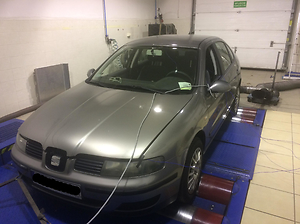Current issue
Online first
Archive
About the Journal
Aims and scope
Publisher and Editorial
Advertising policy
For Authors
Paper review procedures
Procedures protecting authentic authorship of papers
Paper preparation manual
Plagiarism check
Publication ethics
Reviewers
APC
Editorial and Scientific Board
Contact
Reviewers
The analysis of vibrations in the vehicle with naturally aspirated and turbocharged gasoline engine
1
Division of Automotive Engineering, Wroclaw University of Science and Technology, Poland
Submission date: 2020-04-21
Final revision date: 2020-05-10
Acceptance date: 2020-05-12
Publication date: 2020-07-02
Corresponding author
Łukasz ŁOZA
Division of Automotive Engineering, Wroclaw University of Science and Technology, Braci Gierymskich 164, bud. P-14, 51-640, Wroclaw, Poland
Division of Automotive Engineering, Wroclaw University of Science and Technology, Braci Gierymskich 164, bud. P-14, 51-640, Wroclaw, Poland
Combustion Engines 2020,181(2), 19-23
KEYWORDS
TOPICS
ABSTRACT
In this paper, the author presents a study of vibrations in a passenger vehicle and the possible influence on driver’s body in the process of natural operation. The author describes the dependence of engine size and additional equipment as the possible primary source of the vibration variations and their further propagation in the entire vehicle structure. The analysis was performed on the passenger cars with naturally aspirated and turbocharged gasoline engines. The aim of this study was to verify the level of vibrations in the vehicle structure with these particular engines, especially influence of downsized power unit, during various state of engine operation. The second goal was to examine the vibrations in the specified location related to driver’s body. The measuring method used piezoelectric accelerometers, which were attached to the designated locations in the vehicle and were able to detect variations of the acceleration. The signals were collected as characteristics in the time domain. In order to achieve frequency domain for spectral analyses, the author applied the Fast Fourier Transform (FFT).
REFERENCES (24)
1.
Commission Regulation (EC) No 692/2008 of 18 July 2008 implementing and amending Regulation (EC) No 715/2007 of the European Parliament and of the Council on type-approval of motor vehicles with respect to emissions from light passenger and commercial vehicles (Euro 5 and Euro 6) and on access to vehicle repair and maintenance information.
2.
Regulation (Eu) 2019/631 of the European Parliament and of the Council of 17 April 2019 setting CO2 emission per-formance standards for new passenger cars and for new light commercial vehicles, and repealing Regulations (EC) No. 443/2009 and (EU) No 510/2011.
3.
SCHEFFER, C., GIRDHAR, P. Practical machinery vibration analysis and predictive maintenance (Practical Profes-sional). Newnes. 2004.
4.
WORLD HEALTH ORGANIZATION. Occupational exposure to vibration from handheld tools. UMEA Universitet.
5.
BURDZIK, R., KONIECZNY L. Vibration issues in passenger car. Transport Problems. 2014, 9(3), 83-90.
6.
BURDZIK, R., KONIECZNY L. Application of vibroacous-tic methods for monitoring and control of comfort and safety of passenger cars. Solid State Phenomena. 2014, 210, 20-25.
7.
KUMARESH, S.A., ALADDIN, M.F. A study of vibration transmission on seated person in passenger vehicle. AIP Conference Proceedings. 2019, 2137(1).
8.
NAHAVI, H., FOULADI, M.H., NOR, M.J.M. Evaluation of whole-body vibration and ride comfort in a passenger car. International Journal of Acoustic and Vibration. 2009, 14(3).
13.
CADY, W.G. Piezoelectricity: volume one and two: an introduction to the theory and applications of electromechanical phenomena in crystals. Dover Publications. 2018.
15.
GIERGIEL, J. Mechanical vibrations (in Polish). University Scientific-Educational Publishers, Cracow 2000.
18.
Hamownia podwoziowa do kontroli mocy MAHA LPS 300 dla samochodów osobowych, Instrukcja obsługi.
19.
ISO 2631-1:1997 Mechanical vibration and shock – Evaluation of human exposure to whole-body vibration – Part 1: general requirements.
20.
PN-EN 14253:2005 Drgania Mechaniczne. Pomiar i obli-czanie zawodowej ekspozycji na drgania o ogólnym działaniu na organizm człowieka dla potrzeb ochrony zdrowia. Wytyczne praktyczne.
21.
PN-91/S-04100 Drgania. Metody badań i oceny drgań me-chanicznych na stanowiskach pracy w pojazdach.
22.
ŁAZARZ, B., MADEJ, H., CZECH, P. Fotel kierowcy jako element układu tłumienia drgań. Transport. 2009, 65, Zeszyty Naukowe Politechniki Śląskiej.
CITATIONS (1):
1.
Evaluation of materials used for coatings of electrical connectors used in the electrical harness of passengers cars
Paulina Adamczyk, Anna Zięty, Dominika Grygier
Combustion Engines
Paulina Adamczyk, Anna Zięty, Dominika Grygier
Combustion Engines
Share
RELATED ARTICLE
We process personal data collected when visiting the website. The function of obtaining information about users and their behavior is carried out by voluntarily entered information in forms and saving cookies in end devices. Data, including cookies, are used to provide services, improve the user experience and to analyze the traffic in accordance with the Privacy policy. Data are also collected and processed by Google Analytics tool (more).
You can change cookies settings in your browser. Restricted use of cookies in the browser configuration may affect some functionalities of the website.
You can change cookies settings in your browser. Restricted use of cookies in the browser configuration may affect some functionalities of the website.



